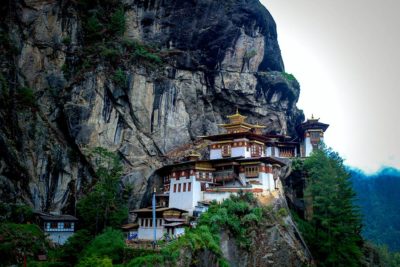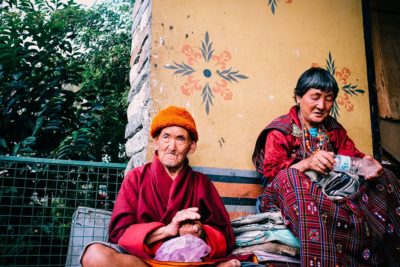Heritage-Luxury Experiences in Bhutan
10 days
This exclusive itinerary, which we like to call a heritage-luxury experience, has been carefully crafted by the experts at Conscious Journeys in each destination to offer those who choose to travel with us the chance to embark on a truly unique journey. In designing this itinerary, we worked closely with local hoteliers—true connoisseurs and passionate ambassadors of their homeland, which for them is simply home. For this reason, the tour becomes a life experience that allows you to discover hidden places, traditional arts, local culture, activities, and typical cuisine in each destination.
This itinerary was designed through personal experience, direct knowledge, and trusted advice from those who live locally, offering a unique stay in Bhutan that goes far beyond the typical tourist circuit. We have curated exclusive experiences in every destination by staying in historic and unique heritage-luxury properties, allowing you to feel a deep connection with the place and enjoy a special stay immersed in its culture and traditions. The selected heritage resorts are respectfully integrated into their environment, with particular attention to every detail—hallmarks of Bhutanese hospitality.
With our curated selection of properties and exclusive activities across the country, this tour will offer you a one-of-a-kind and unforgettable holiday. Our resorts and lodges are not simply places to sleep, but truly special spaces where you can live authentic and meaningful experiences.
This itinerary is designed to explore and experience the sacred sites of Bhutan that were blessed by Guru Rinpoche during his journey from India to Tibet in the 8th century, while also discovering Bhutan’s cultural and ecological wealth—all while staying in the best heritage properties available in each destination.
Unlike its neighboring countries, Bhutan regards all of creation as sacred, including trees, mountains, rivers, and lakes. As a result, animal species that are endangered in surrounding countries like Nepal, India, and Tibet can live in peace here. It is also the last stronghold of Vajrayana Buddhism, a spiritual practice known as one of the most profound schools of Buddhist thought. The sacred monasteries, prayer flags fluttering across the ridgelines, red-robed monks chanting prayers—these elements envelop the kingdom in a timeless aura. This is Bhutan, known to its people as “Land of the Thunder Dragon.”
Even today, in the 21st century, culture remains vibrant and the environment pristine, while the kingdom continues to prosper. Beyond the majesty and magnificence of nature, the environment allows for union with the divine through meditation and contemplation. It is the dwelling place of deities, immortals, and saints in the Himalayas. Over the centuries, wandering yogis, saints, and lay pilgrims have been irresistibly drawn to these remote and rugged mountains in search of inspiration and wisdom.
This journey offers the opportunity to visit consecrated landscapes by following in their footsteps and to rediscover the values of peace and solitude by visiting hidden sanctuaries and ancient ascetic gompas (Buddhist temples), traveling through the still-untouched regions of the Himalayas. No journey to Bhutan would be complete without a visit to the Taktsang Monastery, the “Tiger’s Nest,” blessed in the 7th century by Guru Rinpoche. It is said that he passed through here riding a flaming flying tigress, taking the form of Guru Dorje Drolo (one of his eight manifestations), during his journey from eastern Bhutan to Tibet to protect the Buddhist teachings in Mon-Yul (land of darkness). He meditated here for three months and blessed numerous neys (sacred sites); as a protector of Buddhism, he subdued evil spirits and converted the entire region.
From Gangtey Monastery in the glacial valley of Phobjikha to the traditional art school in Thimphu, from the majestic Punakha Dzong to the unique spiritual trek to Yuling Monastery, and finally to Taktsang suspended between the clouds—this journey will offer a deep immersion into Bhutan’s rich culture and spirituality. Thanks to this special itinerary, you will discover the true essence of this land, with its breathtaking landscapes and natural treasures, while staying in some of the most beautiful heritage resorts in Bhutan.
These resorts represent the best accommodation available in every city you will visit: not just a unique opportunity to enjoy a peaceful and comfortable stay, but special places where you can restore your mental and physical balance.
JOURNEY OVERVIEW AND PROGRAM DETAILS
DAY 1: ARRIVAL IN PARO
Paro – Thimphu
Upon arrival in Paro, you will be welcomed by our representative, your tour guide, and transferred to Thimphu, the capital. The beautiful drive from Paro to Thimphu takes about one hour, following the Paro River to its confluence. After the confluence, the road continues along the Thimphu River valley to the capital. Check-in at the hotel. In the afternoon, visit the tallest seated Buddha statue, the Memorial Chorten, and Bhutan’s national animal, the Takin. Afterwards, visit CTAS (Choki Traditional Art School), located just north of the Bhutanese capital in the scenic mountain valley of Kabesa. Founded in 1999, the school trains underprivileged youth in traditional techniques such as drawing, thangka painting, weaving, embroidery, sculpture, and wood carving. The students live, study, learn trades for their livelihood, and work within the school, which is made up of traditional Bhutanese whitewashed buildings on a sunny hillside among farms and villages. Currently, 136 boys and girls between the ages of 15 and 25 attend the school. Students generally study for six years. Here you will have the opportunity to interact with the students and learn one of these traditional arts. In the late afternoon, you will have the opportunity to take part in a discussion on GNH (Gross National Happiness) with local experts. Free evening for a stroll in Thimphu.
Overnight in Thimphu (B/L/D).
DAY 2: THIMPHU
Thimphu
After breakfast, depart for the excursion to Cheri Goemba Monastery. After about a 30-minute drive to the area of Dodena, you will begin a 45-minute hike along beautiful forest trails leading to Cheri Monastery, built in 1620. This excursion offers the opportunity to immerse yourself in the natural beauty of the Himalayan environment, with the possibility of spotting numerous species of birds along the way. The trail winds through a lush and little-traveled forest. The hike, although steep, is relatively short, and the route is enriched by several sacred sites scattered among the trees. With a bit of luck, it is also possible to observe wild animals such as monkeys or deer. Cheri Monastery is one of Bhutan’s main spiritual retreat centers and an important pilgrimage site. It was founded by Ngawang Namgyal, the Rinpoche who unified Bhutan as a political and spiritual entity. Cheri Gompa serves as a retreat center for the Drukpa Kagyu school of Vajrayana Buddhism. Inside, you can admire a beautiful painting of the Guru carved into the rock.
A packed lunch will be served along the riverbank near a wooden bridge. In the afternoon, return to the hotel and take time to care for body and mind by spending half a day in the hotel spa, with the opportunity to experience various treatments such as the traditional Tibetan Kuney massage, the Detox Tshampa (barley flour), and a purifying Bhutanese massage.
Overnight in Thimphu (B/L/D).
DAY 3: THIMPHU
Thimpu
After breakfast, you will have the opportunity to meet one of the traditional Amchi doctors for a consultation in traditional Tibetan medicine. After the medical visit, you may explore the herbal tea garden and then learn more about Bhutanese traditional cuisine, customs, and etiquette. Traditional lunch will be served at the resort. In the afternoon, enjoy free time with the option to relax at the Spa and experience various traditional treatments.
Overnight in Thimphu (B/L/D)
DAY 4: TRANSFER TO PHOBJIKHA
Thimphu – Phobjikha
After breakfast, depart from Thimphu towards Phobjikha (approx. 5 hours and 30 minutes drive). Phobjikha is a scenic glacial valley shaped like a bowl, located on the western slopes of the Black Mountains and on the edge of the Jigme Singye Wangchuck National Park. This area is renowned as one of Bhutan’s most important nature reserves, as it welcomes a large flock of rare black-necked cranes every winter. These birds feed among the fields and alpine meadows of the valley before returning to Tibet.
Upon arrival, check-in at the hotel and take some time to relax, followed by lunch. In the early afternoon, visit the Crane Information Centre, a facility offering insights into the behaviour of black-necked cranes and the conservation strategies implemented in collaboration with the Royal Society for Protection of Nature (RSPN). A short walk in the surrounding area allows you to overlook the wetlands where the cranes gather during the winter months.
Later, you may attend the evening prayer session at Gangtey Shedra (Buddhist College), located just a 5-minute walk from Gangtey Lodge. About 300 monks currently study in this spiritual centre. After the prayer (from 6:30 to 7:30 PM, except on Saturdays), you may be invited to accompany one of the lamas (Dharma masters) during their evening round, with the opportunity to engage in conversation with the monks. It is also possible to combine the 5:30 PM meditation session with the evening prayer.
Overnight in Phobjikha (B/L/D)
DAY 5: SPIRITUAL TREK BETWEEN DOZHONG AND YULING MONASTERY
Phobjikha – Trongsa
At dawn, you will take part in the Thrusel ritual at the valley’s Shedra—an ancient purification ceremony using sacred fumigation and blessed water. The monks burn dried herbs in ritual braziers, releasing restless spirits and hidden desires into the air, while holy water (thrue-chhu) is gently poured over the head as a sign of auspiciousness. It is a silent and powerful gesture, aligning body, mind, and the universe.
After breakfast, depart towards Trongsa (approx. 2 hours and 30 minutes drive). The road winds through coniferous forests, remote villages, and pastures dotted with prayer flags, until reaching the historical heart of central Bhutan.
Upon arrival in Trongsa, check-in at the hotel and take time to relax, enjoying the mountain stillness and the crisp air scented with pine and incense.
In the afternoon, visit the village of Yuling, a place suspended in time, where the memory of ancient lineages still lingers. Here stands Yuling Lhakhang, once a defensive outpost of Trongsa Dzong against rebel incursions, now transformed into the National Museum of Bhutan. Within its shadowed halls are preserved priceless treasures of the Wangchuck dynasty: sacred diamonds, sculptures of tantric deities, ancient manuscripts, and royal symbols that narrate the birth of modern Bhutan. Each object holds a fragment of eternity.
Later, you will have the opportunity to participate in an intimate and meaningful ceremony: the Prayer Hoisting Ceremony at Willing Lhakhang. Together with monks and the local community, you will raise lung-ta—Tibetan prayer flags—into the wind. As the chants blend with the rustle of pine trees and the sound of bells, each flag releases prayers for peace, health, and prosperity, carried by the wind to the four corners of the world.
Overnight in Trongsa (B/L/D)
DAY 6: TRANSFER TO PUNAKHA
Trongsa – Punakha
Right after breakfast, depart from Trongsa towards Punakha (approx. 5 hours and 30 minutes drive). Along the way, stop at the scenic Dochula Pass to enjoy a breathtaking view of the Himalayan mountains, weather permitting. Here you can also take a walk among the famous 108 chortens, built by Ashi Dorji Wangmo Wangchuck in honor of fallen soldiers.
Continue towards Punakha and, before checking in at the hotel, enjoy a pleasant walk through the rice paddies to the Temple of Fertility, Chimmi Lhakhang, dedicated to the revered “Divine Madman” Drukpa Kunley—an eccentric and spiritual figure of Bhutanese Buddhism.
After check-in and lunch at the hotel, visit the historic village of Ritsha, known as the “model village” for rice cultivation in western Bhutan. Ritsha is located on fertile alluvial land between the Pho Chhu and Mo Chhu rivers, and is known for the production of red and white rice, as well as its traditional mud-and-stone houses surrounded by orchards and organic gardens.
Overnight in Punakha (B/L/D)
DAY 7: LOCAL FARM EXPERIENCE IN PUNAKHA
Punakha
After breakfast, you will begin exploring the culture and traditions of the Punakha Valley. We will drive to the village of Nubgange. Here, you can take part in typical farming activities such as playing darts, archery, and seasonal work in the fields. You will also have the opportunity to observe a cooking demonstration during the preparation of lunch.
Afterwards, you will visit the majestic Punakha Dzong. Built in 1637–38, this sacred monastery is the second oldest and largest dzong in the Land of the Thunder Dragon. It was constructed by Ngawang Namgyal, the first Zhabdrung Rinpoche. Nestled among picturesque mountain peaks, Punakha Dzong is one of the sites soon to be listed as a UNESCO World Heritage site in Bhutan. It is a six-story structure with a central tower, measuring 180 meters in length and 72 meters in width, and features three distinct “dochey” (courtyards).
At the end of the visit, you will enjoy a magnificent view of the Punakha Dzong. Later, you may relax with a traditional hot stone bath (optional).
Overnight in Punakha (B/L/D)
DAY 8: TRANSFER TO PARO
Paro
Early in the morning, you will have the opportunity to take part in the Thrusel morning ritual, an ancient spiritual purification ceremony still practiced daily in many Bhutanese monasteries. During this auspicious ritual, sacred herbs are burned for fumigation, and holy water (thrue-chhu) is poured over the head of the participants to drive away negative influences and honour the protective spirits of the place.
After the ritual, departure from Punakha towards Paro (approximately 4 hours and 30 minutes by road). On the way, stop at Dochula Pass to admire a spectacular view of the Himalayas and enjoy a quiet moment among the 108 chorten. Here, you will also have the chance to hang your prayer flags according to Bhutanese tradition.
Arrival in Paro in the late morning, check-in at the hotel and lunch.
In the afternoon, you will enjoy an immersion into Bhutan’s cultural and recreational traditions: you can attend a demonstration of archery and darts, try your hand at these traditional games, and learn about the Bhutanese national dress, such as the gho and kira.
Afterwards, you may enjoy a moment of complete relaxation at the Jiva Spa, where holistic treatments inspired by traditional medicine will offer a regenerating experience for mind, body and spirit.
Overnight in Paro (B/L/D)
DAY 9: HIKE TO THE TIGER’S NEST MONASTERY
Paro
After breakfast, start the day with a short drive to the upper valley of Paro. On a clear day, you can enjoy an unforgettable view of Mount Chomolhari, the “Goddess”, which rises to 23,640 feet. Then, a brief transfer to the starting point of the Taktsang trail. Hike to Taktsang Monastery, the most famous in Bhutan. Taktsang means “Tiger’s Nest”, so called because it is said that Guru Rinpoche flew to this place on the back of a flying tigress in the late 7th century. Surrounded by blue pines and a clear sky, the monastery rises miraculously on a cliff nearly 2,700 feet above the Paro valley floor. Here, you can offer a butter lamp.
Lunch at Taktsang Café. Afterwards, visit a farmhouse where you can observe various traditional Bhutanese methods for making rice wine, preparing Zaw and Suja (butter tea), and learn the traditional games of archery and Degor (a game played with stones). In the evening, enjoy a traditional hot stone bath. Return to the hotel for a well-deserved rest.
Overnight in Paro (B/L/D)
DAY 10: DEPARTURE FROM PARO
Paro
Transfer to the airport and departure on your international flight. We hope you will carry this noble country in your heart: may it bring you peace.
ACTIVITIES
- Discover the city of Thimphu, capital of Bhutan
- Take part in a yoga and meditation session at the resort
- Visit the Buddha Dordenma statue, the Memorial Chorten, and the Takin enclosure
- Explore the Choki Traditional Art School and interact with students of traditional arts
- Hike through Himalayan forests to Cheri Monastery, a spiritual retreat center
- Receive a traditional medicine consultation from an Amchi doctor and visit the herbal garden
- Discover Bhutanese culinary art and traditional etiquette during a cultural lunch
- Join the evening prayer and, optionally, meditation at the Gangtey Shedra Monastery
- Join the monks for a morning Thrusel purification ritual
- Experience a full-day spiritual trek from Dozhong Goemba to Yuling Monastery, through forests, sacred rocks, and remote temples
- Admire the view from Dochula Pass and hang your prayer flags
- Walk through rice fields to the Chimmi Lhakhang Fertility Temple
- Visit the farming village of Ritsha and learn about Bhutanese rice cultivation
- Discover the majestic Punakha Dzong, one of the most important in the country
- Attend a demonstration of traditional Bhutanese archery and darts in Paro
- Relax with rejuvenating treatments inspired by Bhutanese medicine at the Jiva Spa
- Hike to Taktsang Monastery, the Tiger’s Nest, perched on the cliffs of Paro’s high valley
- Admire the unforgettable view of Mount Chomolhari
SOCIAL AND ENVIRONMENTAL IMPACT
This itinerary has been designed to promote direct and indirect benefits for local communities, the environment, and cultural heritage. For this tour, we have selected luxury traditional accommodations owned by local families, which represent the best options in each destination and show sensitivity to social and environmental issues, following the general principles and practices of responsible tourism.
The tour is structured to include activities in contact with various local and tribal communities, including visits to villages such as Ritsha. Bhutan is a treasure trove of indigenous culture, multi-ethnic groups, and hill tribes. It is surprising that such a small country has 19 different dialects, making Bhutan a truly unique destination.
To benefit local communities, the Bhutanese government has decided to open certain indigenous villages to visitors while preserving natural resources and respecting local lifestyles. These communities are involved in environmentally sustainable practices, contributing to schools, libraries, and wildlife conservation, which also supports Gross National Happiness (GNH).
In Thimphu, the capital of Bhutan, the tour supports the Choki Traditional Art School (CTAS), whose mission is to preserve traditional Bhutanese arts and crafts and prevent their disappearance, while equipping young people with livelihood skills. CTAS is the only private institute in Bhutan offering training in traditional arts and crafts, providing free education, accommodation, and meals to economically disadvantaged youth.
By teaching and promoting traditional Bhutanese skills, the institute has high potential for job creation. The Zorig Chusum (Thirteen Traditional Arts) can become a real source of income and employment.
In Thimphu, you will also visit a voluntary art studio known as VAST, founded in 1998 by a group of professional artists as a non-profit, non-governmental organization. This informal organization was established to give young Bhutanese the opportunity to participate in and develop their artistic talents, as well as to foster social responsibility through artistic exploration and other socially useful and productive activities. Its main goal is to provide professional skills and an alternative, positive use of free time by facilitating participation in both national and international art worlds.
TIPS BEFORE DEPARTURE
This itinerary offers opportunities for cultural exchange, adventure, hiking, and bird and nature watching. However, it is not suitable for everyone due to the walking excursions and the altitudes reached. It is advisable to consult your doctor to ensure you are fit for the trip and to receive advice on any necessary precautions.
Due to the climate and limited medical facilities, we recommend traveling only in excellent health.
It is important to maintain behavior that respects the local culture to avoid problems or misunderstandings during the trip. In particular, public displays of affection, such as kissing or hugging, are discouraged and not well accepted.
A mindful approach to travel requires a considerable degree of openness and willingness to adapt to the local culture and environment. If you choose to travel with us, we ask you to be fully open to the local culture, religion, and traditions, setting aside any prejudices or preconceived notions shaped by Western ways of thinking.
Seeing Bhutan with new eyes, with patience and openness, will allow you to experience the authentic essence of its cultural heritage through the places and people you meet.
With this small effort, you will truly be able to appreciate the beauty of the culture and spirituality of both countries, the wonder of nature, the solemnity of Buddhist monasteries, and the sacred places blessed by Guru Padmasambhava himself.
In Bhutan, the weather can be humid with sporadic or prolonged rainfall. We recommend bringing appropriate clothing, including for rainy conditions. Mornings and evenings can be quite cold, especially between October and April, so warmer clothes may be necessary. Layered clothing is the best option.
We advise wearing comfortable walking or hiking shoes. Due to the altitude, you will need a hat or sunglasses.
Given the distance between villages and towns, it is important to bring all necessary medications. A flashlight, water bottle, polarizing camera filter, and backpack are also recommended.
Finally, remember that temples and monasteries are places of worship, and visitors must dress respectfully. Entry may be denied to men and women wearing short skirts, shorts, or sleeveless shirts.
Entering Bhutan is not simple. The government strictly monitors all incoming and outgoing visitors. Travel in the country is only possible with an authorized guide and a group visa, which is issued at the border with Sikkim (this visa is not individual and does not allow independent travel). The guide will accompany the group until departure.
If you wish to visit Bhutan during festivals, we strongly recommend contacting us well in advance.
HOTELS
In Bhutan, for each city, we have selected the finest heritage luxury resorts to make your stay comfortable and relaxing as you explore this fascinating country. Our carefully chosen luxury resorts represent the best way to discover the cultural heritage and hospitality of this colorful Himalayan kingdom, surrounded by breathtaking landscapes while enjoying all modern comforts.
For this tour, we have selected the following properties:
Kolkata: Rajkutir
Located in the heart of Kolkata, this majestic mansion-style hotel immerses you in the atmosphere of the Bengal Renaissance. Raajkutir is designed in the style of a traditional Bengali Raajbari, the sprawling homes of wealthy landowners. The hotel is built around a large traditional Uthon (courtyard). The entrance is flanked by lion sculptures depicting Bengali royalty. A grand rural Bothhtola with sacred threads hanging from an old Banyan tree and an idol of Durga evoke the welcoming spirit of a typical 19th-century setting. Its refined heritage aesthetic, beautiful banquet spaces, and hospitality inspired by Bengali traditions will transport you to the relaxed lifestyle of a bygone era.
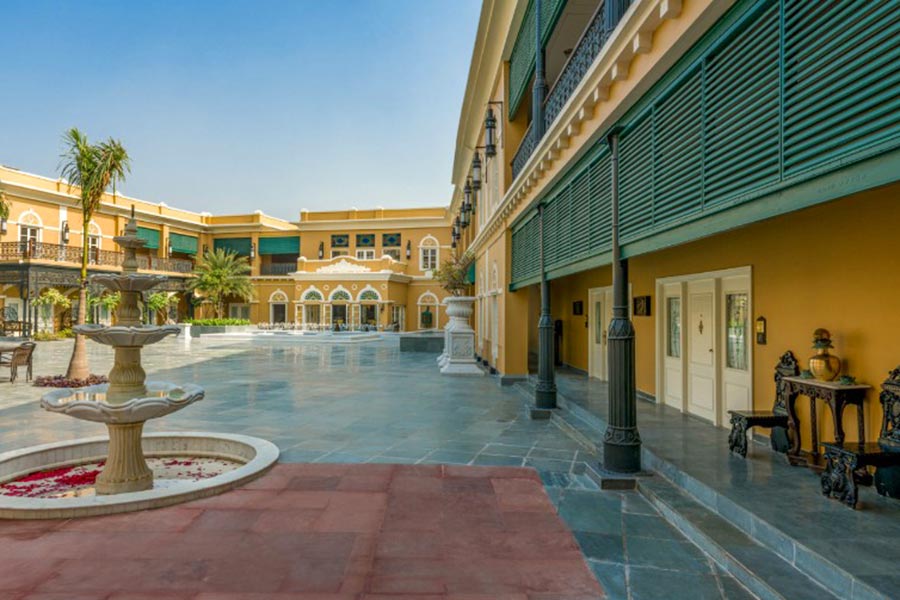
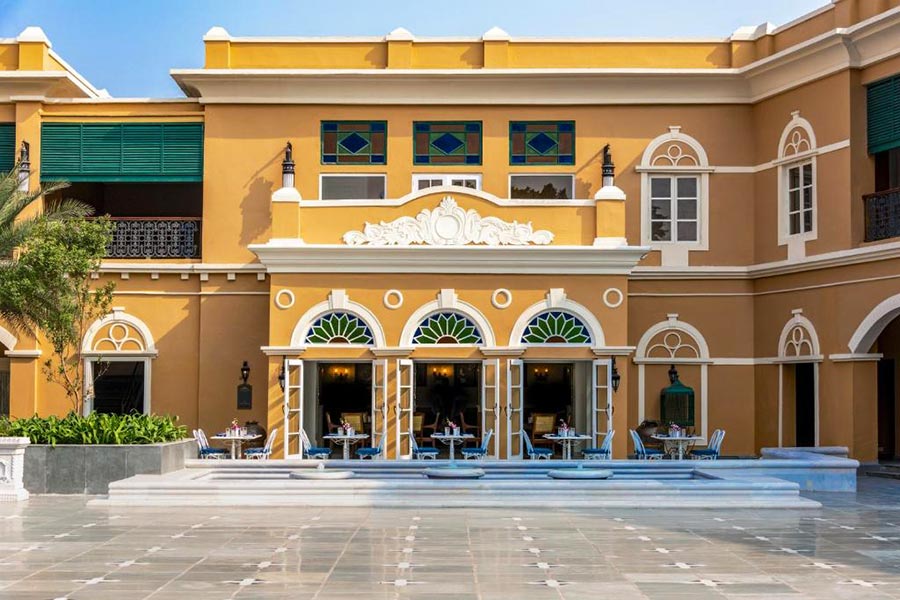
Thimpu: Therma Linca
Therma Linca in Thimphu is committed to offering the best experience to travelers visiting the Himalayas. This resort features beautiful artwork masterfully created by local artists and combines the beauty of nature with the comfort of modern amenities, including a swimming pool and a wellness center offering various traditional treatments. This special resort represents a serene and peaceful place that will make your journey enjoyable and is the perfect spot to relax in a breathtaking Himalayan setting.


Punakha: Dhensa Boutique Resort
Dhensa Resort is located in the heart of the peaceful and lush Punakha Valley. Flanked by dense pine forests, it overlooks the Punakha River and hundreds of rice terraces cascading down to the valley floor. Its 24 suites are spread across 6 cottages, each equipped with a private balcony. The spacious interiors are intentionally minimalist and designed for the modern traveler. This special resort is a true oasis of peace and tranquility, offering deep relaxation surrounded by the breathtaking landscapes of one of Bhutan’s most beautiful valleys. Here, guests can enjoy a profound sense of calm, further enhanced by the Spa, which offers traditional Bhutanese treatments aimed at refreshing and rejuvenating the body and mind.


Phubjikha: Gangtey Lodge
The multi-award-winning Gangtey Lodge Bhutan offers every comfort and luxury in one of the most remote places in the world. This heritage-luxury lodge, located near a cluster of farms, is perched above the spectacular Gangtey (Phobjikha) Valley. Its breathtaking location and extraordinary design in the heart of Bhutan allow guests to step back in time, far from the stress and distractions of modern life. The fourth of the five valleys that make up Bhutan, the Gangtey Valley is a protected reserve for the black-necked cranes and remains untouched by the outside world. At Gangtey Lodge, you will have the opportunity to focus on the five keys to well-being while immersing yourself in the culture and natural surroundings of the Gangtey Valley. From spiritual blessings and community engagement to physical and mental rejuvenation, our authentic experiences will help you reconnect with yourself and your loved ones.


Trongsa: Willing Resort
Willing Resort is nestled in the heart of the hills of Trongsa, overlooking breathtaking views that stretch across the surrounding mountains and valleys. Immersed in tranquility and surrounded by lush nature, it offers a perfect balance of simplicity and authenticity. The spacious rooms, decorated in traditional Bhutanese style, provide modern comforts and enchanting views of the mountains. The resort is family-run and fully reflects the spirit of Bhutanese hospitality – attentive, discreet, and warm. Thanks to its strategic location, it serves as the ideal starting point to visit the Trongsa Dzong and to experience spiritual moments in the nearby monasteries. Willing Resort is a welcoming retreat where you can unwind after your excursions, surrounded by an authentic and serene atmosphere.
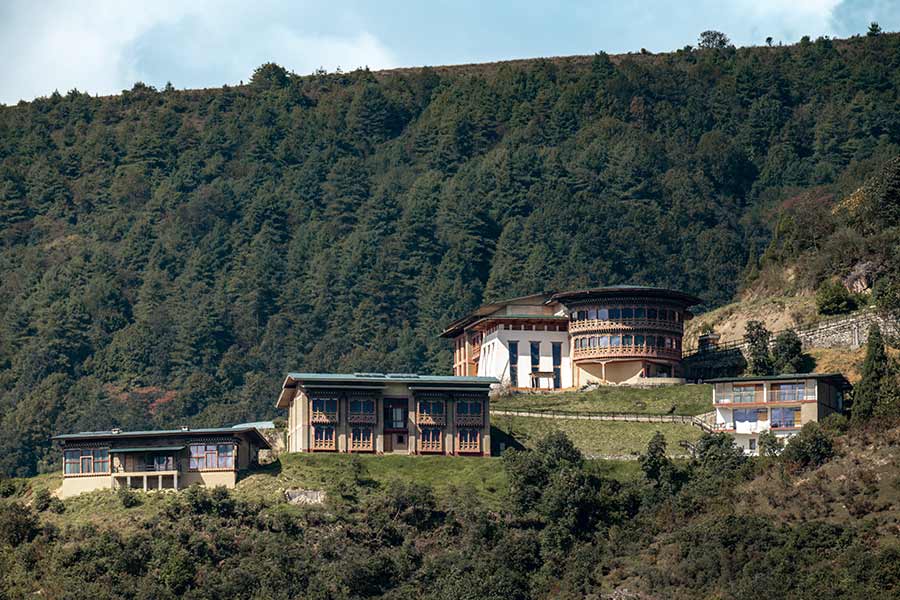
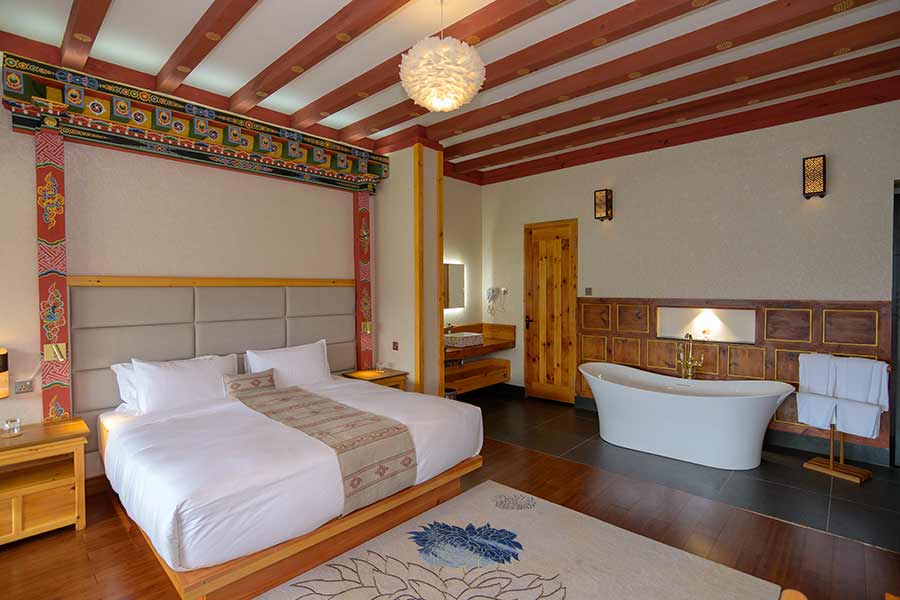
Paro: Zhiwa Ling
Zhiwa Ling Heritage is a five-star hotel perfectly integrated with nature, culture, and tradition, where you can escape the ordinary and immerse yourself in the genuine warmth and comfort typical of Bhutan. Nestled in the enchanting Paro Valley, Zhiwa Ling offers a truly exceptional experience, enhancing every aspect of your journey. Here, you will have the opportunity to experience the essence of Bhutanese culture by taking part in authentic activities such as a traditional Bhutanese tea ceremony at the picturesque Heritage Tea House, practicing yoga and meditation, and attending demonstrations of archery and darts, learning to master Bhutan’s traditional games.
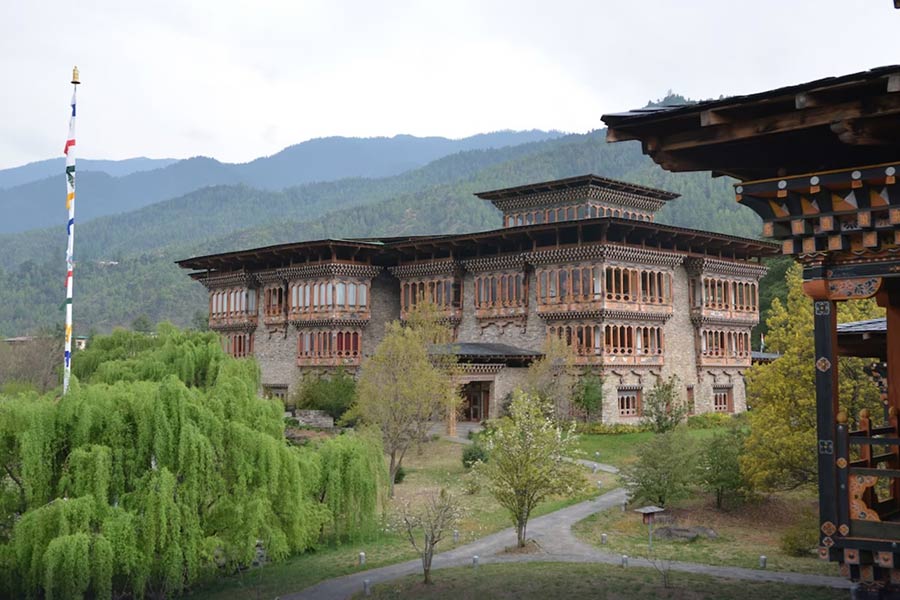

TRANSPORT
For this tour, comfortable and air-conditioned cars or minibuses (depending on the number of participants) will be used throughout the entire journey. A flight from Kolkata to Bagdogra is included.
WHEN TO GO
Bhutan can be visited all year round, but the best periods are from March to May (spring) and from mid-September to mid-November (autumn).
In spring, you can admire the stunning colors of nature and attend the famous Tsechu festival in Paro, one of the most colorful and significant events in the district. In autumn, with clear skies and crisp air, you can enjoy views of some of the highest mountains on Earth. It is the ideal time for trekking and to attend the Tsechu festival in Thimphu.


